Pupation
When a larva becomes full grown, it undertakes a final moult to become a pupa. For a day or two prior to pupation the larva goes through a wandering phase when it usually leaves its foodplant and may walk up to a kilometre before finding a suitable place to undertake the transformation into a pupa. During this phase it is very prone to predation. Dispersal however probably reduces overall predation of pupae by spreading them over a wider area – if they were concentrated on or around the foodplant it would be easier for birds to home in on them and wipe out the whole brood.
Larvae pupate in different ways depending on which family they belong to. A larva from the family Nymphalidae for example will spin a tiny button of silk on a leaf or stem, and anchor itself to it by its tail. The tail has an appendage called a cremaster, which is equipped with microscopic hooks to hold it securely to the silk.
Larvae of Papilionidae and Pieridae do the same, but additionally spin a silken girdle around their waist. Lycaenidae and Riodinidae don’t possess cremasters so they either pupate on the ground, or attach themselves by a silk girdle to a leaf or stem. Hesperiidae pupate loosely, usually within a flimsy silken tent. The larvae of most moths pupate loosely in a chamber just below the surface of the ground. Others, including Saturniidae, Bombycidae and Lasiocampidae pupate inside a tough silk cocoon spun on the leaves, stems or branches of their foodplants.
The pre-pupal caterpillar remains motionless for 2-3 days preparing itself for its final moult. During this time the prolegs start to shrink, the thoracic segments become enlarged, and the larva adopts a curled hump-backed position.
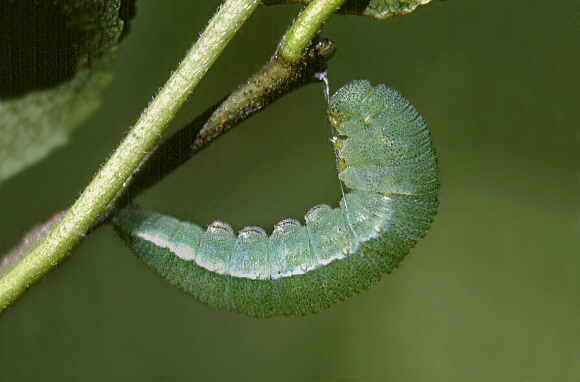 Gonepteryx rhamni, fully grown larva ( pre-pupa ) just prior to the final moult – Adrian Hoskins
Gonepteryx rhamni, fully grown larva ( pre-pupa ) just prior to the final moult – Adrian Hoskins
When the final moult takes place the skin splits behind the head, but instead of a caterpillar walking out of the old skin, what emerges is quite different in nature – a legless, wriggling, non-eating entity called a pupa or chrysalis.
At first the pupa is soft, limp and highly vulnerable to attack by parasitoid wasps and flies. Within a few hours however the skin hardens into a tough shell that will protect the insect until it ultimately emerges as an adult butterfly or moth.
The pupae of many Lycaenidae species are attended by ants ( see myrmecophily ). The presence of ants is beneficial to the pupae because ants drive away predatory insects and parasitoid wasps that would otherwise attack them. Experiments with the Australian hairstreak Jalmenus evagoras for example have shown that in cases where ants have been denied access to the pupae the latter have suffered up to 95% parasitism by the wasp Brachymeria reginia. Conversely, pupae attended by the ants experienced zero parasitism.
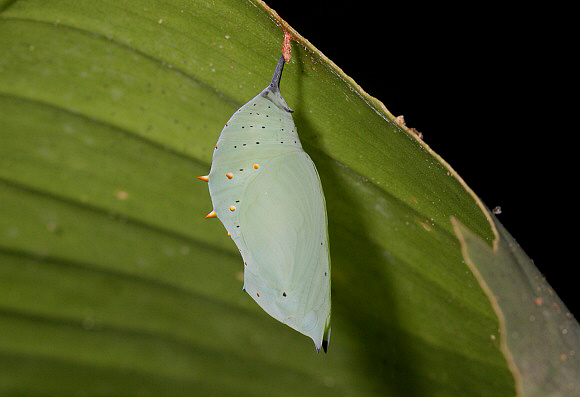
Siproeta epaphus ( Nymphalinae ), Peru – Adrian Hoskins
Caterpillars show no external evidence of sexuality, but pupae can be distinguished as male or female. A male pupa will have 2 tiny bumps close to it’s tail, corresponding with the anal claspers of the adult butterfly or moth. It is also usually slimmer and lighter than a female pupa.
Many other anatomical details of the adult butterfly can be seen on the pupa – e.g. antennae, legs, eyes, wing cases and palpi.
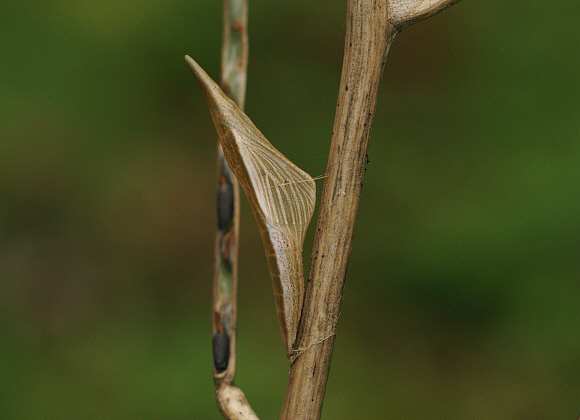 Anthocharis cardamines ( Pierinae ), pupa attached to garlic mustard stem – Adrian Hoskins
Anthocharis cardamines ( Pierinae ), pupa attached to garlic mustard stem – Adrian Hoskins
Butterflies in the families Nymphalidae, Papilionidae and Pieridae usually pupate openly, attached to leaves, stems or twigs. These unprotected pupae are highly vulnerable to predation and parasitism. They are usually cryptically coloured and patterned to resemble foliage, lichens, bird droppings or other common natural objects. This protective resemblance makes it much harder for birds and small mammals to locate them, and increases their chances of survival.
Many species of Papilionidae and Pieridae are able to increase their chances of survival individually, by producing pupae which differ in colour according to their surroundings. Laboratory experiments have shown that on the days prior to pupation caterpillars can detect the colour of the surrounding vegetation and that this triggers a genetic response which decides whether the ultimate pupa will be green or brown.
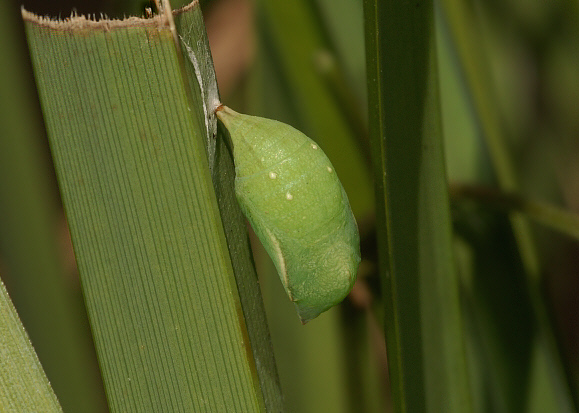 Speckled Wood Pararge aegeria ( Satyrinae ), pupa attached to pendulous sedge – Adrian Hoskins
Speckled Wood Pararge aegeria ( Satyrinae ), pupa attached to pendulous sedge – Adrian Hoskins
Many butterfly pupae in addition are adorned with spines, keels, knobs and other protrusions. They are also frequently contorted into strange shapes. The overall effect is that they often very strongly resemble twisted and desiccated dead leaves or bits of wood. Other butterflies such as Ithomiinae and Danainae are smooth, bulbous and silvery, looking like glistening rain drops.
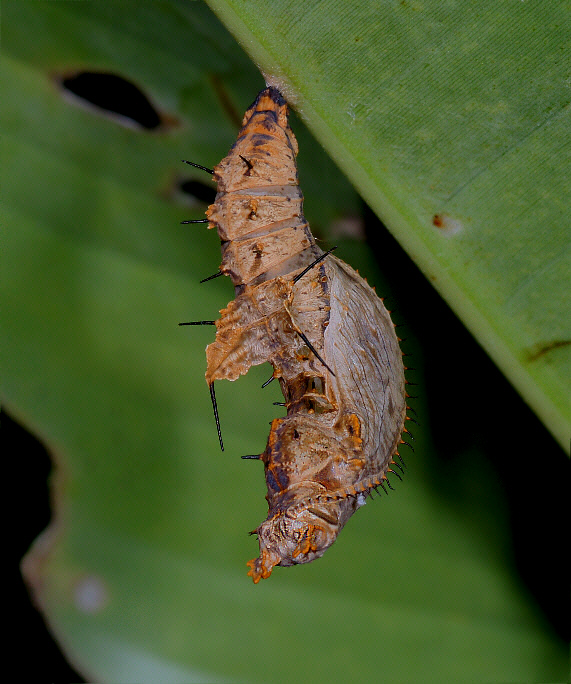 Heliconius pupa, probably melpomene ( Heliconiinae ), Rio Madre de Dios, Peru – Adrian Hoskins
Heliconius pupa, probably melpomene ( Heliconiinae ), Rio Madre de Dios, Peru – Adrian Hoskins
The use of protective resemblance as described above is a form of passive defence, but there are a small number of pupae which use active defence e.g. the neotropical Brassoline Dynastor darius has a pupa that resembles a snake’s head. Another well known example is the pupa of the Deaths Head Hawkmoth Acherontia atropos, which wiggles and squeaks if molested. The squeaking sound is produced by forcing air in and out of the spiracles.
Cocoons
Most Skipper larvae ( Hesperiidae ), and those of moth families including Lasiocampidae, Arctiidae, Saturniidae, Notodontidae and Zygaenidae pupate within cocoons. These range from flimsy affairs composed of little more than a few strands of silk, to hardened shells made of dozens of layers of silk interwoven with bits of chewed bark, such as that of the Puss moth Cerura vinula.
Some cocoons are formed among living foliage on trees and bushes, while others including that of the American Moon moth Actias luna are formed among dead leaves on the forest floor. The cocoon of the Emperor moth Saturnia pavonia has a lobster-pot design with a special “door” which allows the moth to make its escape, but prevents other creatures from entering.
One of the strangest and most beautiful cocoons is that of the Amazonian moth Urodus ( Urodidae ) which has a coarse open mesh design with an exit at the bottom, and hangs like a pendulum from a 20cm long silk cord. It seems likely that the cord may function to isolate the pupa from marauding ants, but little is known about the biology of this species.
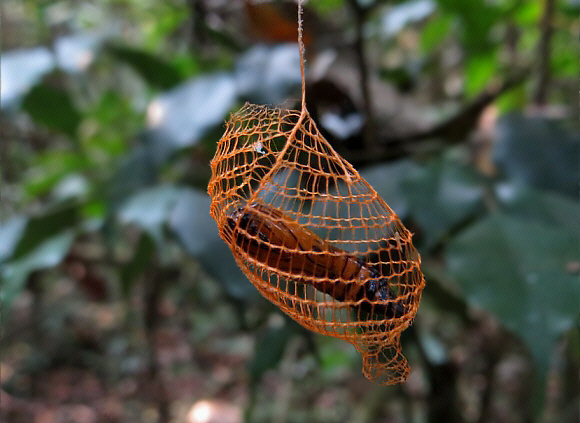 Urodus cocoon, Peru – Phil Torres
Urodus cocoon, Peru – Phil Torres
The cocoons of the silkworm moth Bombyx mori ( Bombycidae ) have been used for centuries for the production of silk. Several species in the family Saturniidae including Antheraea mylitta also produce silk of commercial quality.
Diapause
The pupal stage of the lifecycle can last anything from 1 to 40 weeks depending on the species. In polyvoltine species ( those which have more than one generation per year ), the summer pupal stage will be short – often just a few days; but the 2nd brood may overwinter as a pupa from August or September until the following May or June.
Some species occasionally delay their emergence and remain as pupae for 2 or more winters. This is a natural safeguard because in an unusually short or harsh summer a species might be unable to breed in viable numbers. By staggering its emergence over 2 or 3 years it spreads the risk and ensures that at least a few adults will appear and reproduce each year, regardless of the weather.
Metamorphosis
The popular belief that the bodily fluids within the pupa break down into a “soup” and later reform in the shape of a butterfly is largely untrue. The change from larva to adult butterfly is actually a very gradual process. Clusters of stem cells from which the wings develop are present in segments 2 and 3 of small larvae.
They replicate and diversify during larval development. In the last few days prior to pupation the development accelerates, so that the wings are almost fully formed at the time of pupation. The same applies to the antennae, eyes and palpi, all of which are visible on the newly formed pupa.
Within the pupa the changes that take place are surprisingly minor. The wing scales develop as plate-like extensions from cells on the wing surface. The heart, brain, eyes, antennae, proboscis etc all develop from the fairly simple organs “hidden” within the larva, into the recognisable features of an adult butterfly.
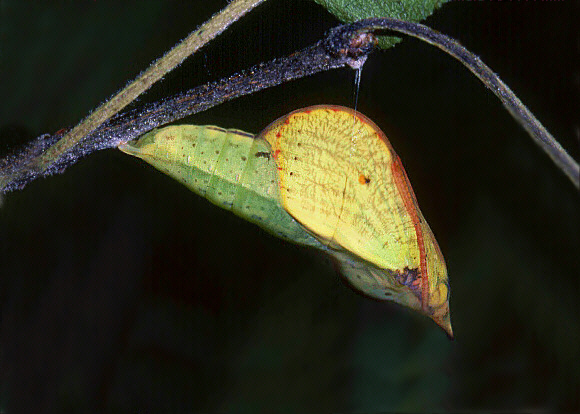
Gonepteryx rhamni with wing patterns showing through, just prior to emergence – Adrian Hoskins
About 2 or 3 days before the butterfly is due to emerge it changes colour, and the colour and pattern of the wings can usually be clearly seen.
At this stage female pupae of many species exude pheromones which attract males even before the butterfly has emerged. In Costa Rica e.g. I have observed that female pupae of Heliconius erato, when close to emergence, often have several male adults in very close attendance.
A frantic battle takes place the instant the female hatches, as all the males struggle to copulate with her, not even allowing her time to expand and dry her wings. The mated pair then have to endure the continuing aggravation of the remaining males, which are often extremely persistent, trying to prise the pair apart. Eventually, with the approach of dusk, the unsuccessful males disperse, allowing the pair to remain copulated until the next morning.
